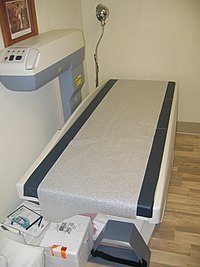
Photo from wikipedia
In addition to bisphosphonates, eldecalcitol is effective for the prevention of glucocorticoid-induced osteoporosis (GIO) [1]. Several strategies for avoiding GIO have been developed. Although steroids are a principal therapy for… Click to show full abstract
In addition to bisphosphonates, eldecalcitol is effective for the prevention of glucocorticoid-induced osteoporosis (GIO) [1]. Several strategies for avoiding GIO have been developed. Although steroids are a principal therapy for myasthenia gravis (MG), GIO reduces the quality of life of MG patients [2]. However, I have a deep concern that most neurologists pay insufficient attention to GIO, although long-term treatment with steroids is necessary for the management of patients with various neurologic autoimmune diseases. I investigated 35 MG patients (M:F = 9:26, mean age 54 years) who repeatedly underwent bone mineral density (BMD) assessment at the femoral neck and lumbar spine (L2–L4) using a dual-energy X-ray absorptiometry system. All patients continued steroid therapy for 7.9 years with daily prednisolone at a dose of 8.3 mg on average. I divided the MG patients into those receiving monotherapy with bisphosphonates (n = 20), including 15 receiving risedronate and 5 receiving alendronate, and those with eldecalcitol (n = 15). There were no differences in gender, age, prednisolone treatment, body mass index, parental hip fracture, smoking, or excess of alcohol intake (Table 1). Chronological changes of serum bone-specific of alkaline phosphatase also yielded no specific differences. After 2-year of treatment, the decrease of BMD in the femoral neck was less in the eldecalcitol group than in the bisphosphonates group. The reduction of BMD in the lumbar spine was only slightly less in the bisphosphonates group than in the eldecalcitol group. Thus, the effects of bisphosphonates and eldecalcitol on BMD in the femoral neck and lumbar spine were almost equivalent in steroid-treated MG patients. Physical inactivity caused by muscle weakness and a lack of outdoor activity, and decreased exposure to sunlight due to disability in MG patients may be related to GIO. A population-based retrospective cohort study in Taiwan showed that MG was associated with a high risk of GIO [3]. However, the management of GIO in MG patients has not been fully discussed. Lv et al. reported that the combination of alendronate and alfacalcidol increased BMD in MG patients after 1 year of treatment [4]. Receiving glucocorticoid therapy for a long duration may be more likely to develop GIO compared to receiving the maximum dose of prednisolone. The BMD decrease over a period of 2 years in MG patients observed in the present study may be acceptable. However, it should be noted that the present study included only MG patients with good medication compliance but did not include those who did not continue taking bisphosphonates. Furthermore, MG patients who had already suffered from severe GIO or repeated fractures that had been followed by orthopedists were excluded. Treatment selection should be individualized and could take into account the association between GIO and underlying autoimmune disorders. In this regard, denosumab is expected to produce better outcomes in MG management [5].
Journal Title: Journal of Bone and Mineral Metabolism
Year Published: 2021
Link to full text (if available)
Share on Social Media: Sign Up to like & get
recommendations!